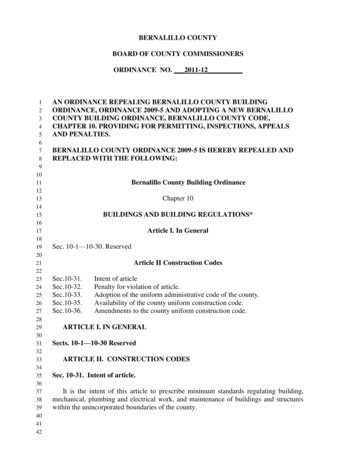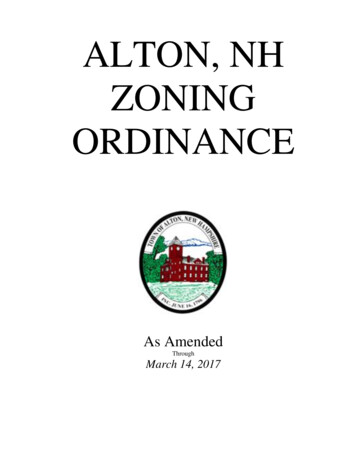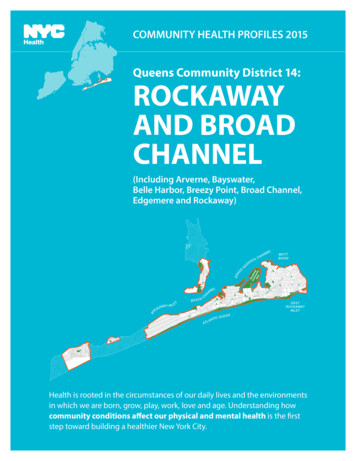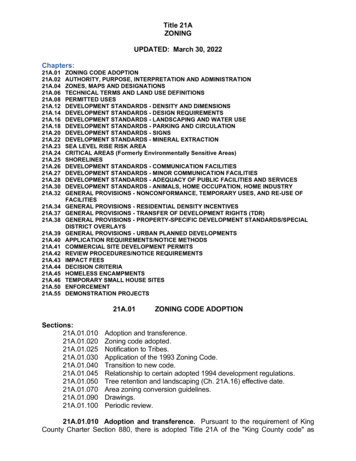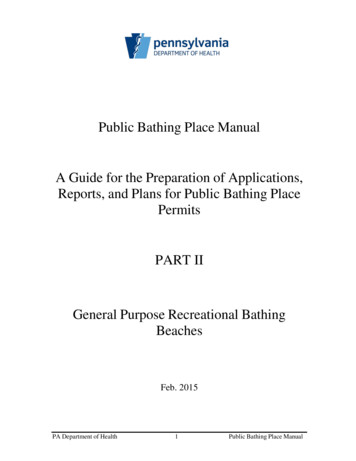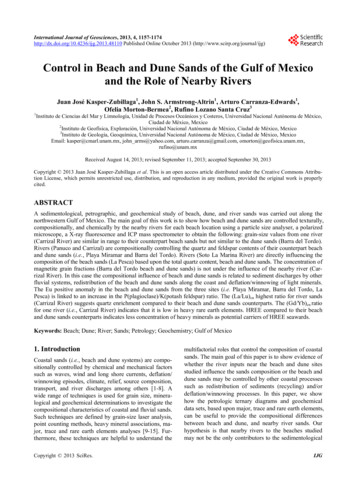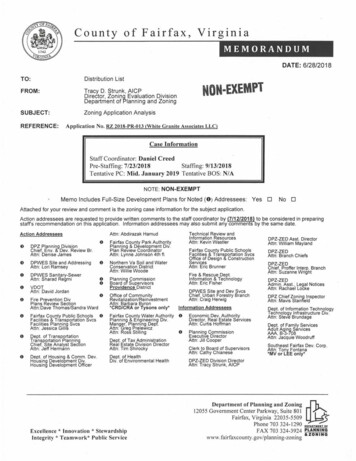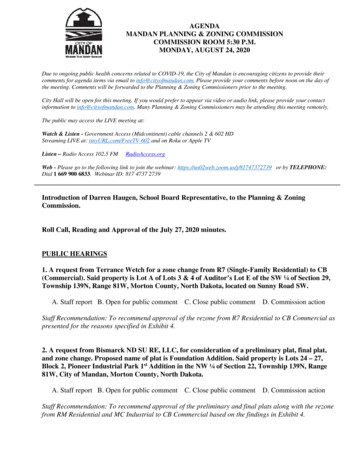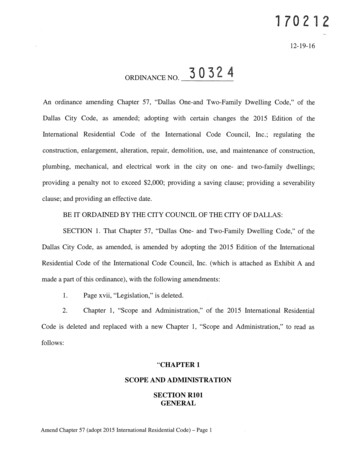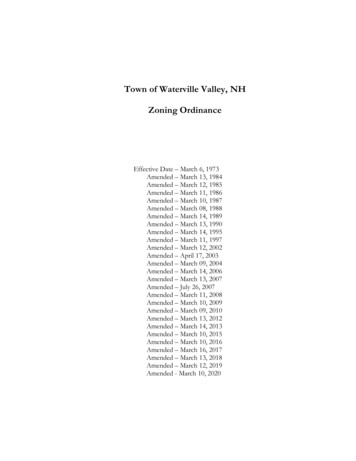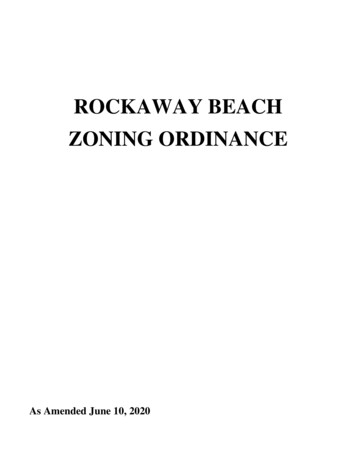
Transcription
ROCKAWAY BEACHZONING ORDINANCEAs Amended June 10, 2020
ROCKAWAY BEACH ZONING ORDINANCETABLE OF CONTENTSArticle 1. Introductory Provisions.Section 1.010. Title. 7Section 1.020. Purpose. 7Section 1.030. Definitions. 7Article 2. Basic Provisions.Section 2.010. Compliance With Ordinances. 13Section 2.020. Classification of Zones.13Section 2.030. Location of Zones. 14Section 2.040. Zoning Map. 14Section 2.050. Zone Boundaries.14Section 2.060. Zoning of Annexed Areas. 14Article 3. Use Zones.Section 3.010. Single Family (R-1) Zone. 15Section 3.020. Residential Zone (R-2).16Section 3.030. Residential/Resort Zone (R-R). 18Section 3.040. Special Residential/Resort Zone (S/R/R). 20Section 3.050. Commercial Zone (C-1). 21Section 3.080. Special Area Wetlands (SA). 23Section 3.090. Lower Density Residential Zone (R-3). 25Section 3.091. Residential Manufactured Dwelling Zone- (RMD) Zone. 27Section 3.092. Flood Hazard Overlay Zone - (FHO) Zone. 29Section 3.093. Definitions. 29Section 3.094. General Provisions. 32Section 3.095. Administration. 32Section 3.096. Provisions for Flood Hazard Reduction.35Section 3.097. Restrictions and Prohibited Uses. 392
Section 3.100. Hazards Overlay Zone (HO). 39Section 3.102. Zone Boundaries. 40Section 3.104. Site Investigation Reports Required. 40Section 3.106. Method For Minimizing Soils Hazards. 40Section 3.108. Method For Minimizing Dune Hazards. 40Section 3.110. Method For Minimizing Steep Slope Hazards.41Section 3.112. Issuance of Permits in Potential Hazard Areas.42Section 3.114. Additional Provisions. 42Section 3.120. Open Space Zone (OS).42Section 3.130. Wetland Notification Overlay Zone. 43Section 3.131. Zone Boundaries. 43Section 3.132. General Provisions. 43Section 3.140 Tsunami Hazard Overlay Zone 43Section 3.150 Public Facilities Zone 47Article 4. Supplementary Provisions.Section 4.010. Access Requirement. 49Section 4.020. Clear Vision Areas. 49Section 4.030. Maintenance of Minimum Ordinance Requirements. 49Section 4.040. Dual Use of Required Open Space. 49Section 4.041. Shoreland Development Criteria. 49Section 4.043. Multifamily Siting Criteria. 50Section 4.050. Sign Requirements. 50Section 4.060. Off-Street Parking and Off-Street Loading Requirements.51Section 4.065. Street and Drainage Standards. 54Section 4.070. Fence Requirements. 54Section 4.090. Home Occupations. 55Section 4.091. Standards For Manufactured Homes. 55Section 4.095. Manufactured Dwelling Siting Criteria.356
Section 4.096. Recreational Vehicle Siting Criteria. 56Section 4.100. Recreation Vehicle Parks. 57Section 4.110. Manufactured Dwelling Park Standards. 57Section 4.120. Shoreline Stabilization Standards. 59Section 4.130. Foredune Grading. 60Section 4.135. Dune Construction Standards. 61Section 4.140. Maintenance of Access. 61Section 4.150. Riparian Vegetation. 61Section 4.160. Archeological Site Protection. 62Section 4.170 Accessory Dwelling Units 63Section 4.180 Mobile Food Unit Pods . 64Article 5. Exceptions.Section 5.010. Zone Boundaries. 65Section 5.020. Authorization of Similar Uses. 65Section 5.030. General Provisions Regarding Accessory Uses. 66Section 5.040. Projections from Buildings. 66Section 5.050. General Exception to Lot Size Requirements. 66Section 5.060. General Exceptions to Yard Requirements. 66Section 5.070. General Exception to Building Height Limitations. 67Section 5.080. Planning Commission Exception. 67Article 6. Conditional Uses.Section 6.010. Authorization to Grant or Deny Conditional Uses.67Section 6.020. Conditional Use Review Criteria. 67Section 6.030. Conditional Use Procedure.67Section 6.040. Non-Profit Conference Ground or Center.68Article 7. Nonconforming Uses.Section 7.010. Continuation of Nonconforming Use. 68Section 7.020. Discontinuance of Nonconforming Use. 684
Section 7.030. Change of Nonconforming Use. 68Section 7.040. Destruction of a Nonconforming Use or Structure. 68Section 7.050. Completion of Structure. 68Section 7.060. Alterations Necessary to Comply With Other Laws. 69Section 7.070. Enlargement or Expansion of a Nonconforming Use. 69Article 8. Variances.Section 8.010. Purpose. 69Section 8.020. Criteria. 69Section 8.030. Conditions. 70Section 8.040. Application. 70Section 8.050. Variance Review Procedures. 70Section 8.080. Compliance With Conditions of Approval. 70Section 8.090. Vested Interest in Approved Variances. 70Section 8.100. Revocation. 70Section 8.110. Limitation on Refiling of Application. 70Section 8.120. Time Limit for an Approved Variance. 70Article 9. Amendments.Section 9.010. Authorization to Initiate Amendments. 70Section 9.015. Burden of Proof. 70Section 9.020. Amendment Procedures. 70Section 9.030. Record of Amendments. 71Section 9.040. Limitation of Reapplications.71Section 9.050. Change of Zone for Manufactured Dwelling Parks. 71Article 10. Planned Unit Development (PUD).Section 10.010. Intent. 71Section 10.020. Purpose. . 71Section 10.030. Permitted Buildings and Uses.71Section 10.040. Development Standards.715
Section 10.050. Procedure - Preliminary Development Plan.72Section 10.060. Procedure - Final Approval.73Section 10.080. Adherence to Approved Plan and Modification Thereof.74Article 11. Administrative Provisions.Section 11.020. Building Permits.74Section 11.030. Application Information and Procedures.74Section 11.040. Notice of Public Hearing.75Section 11.050. Date of Public Hearing. 76Section 11.055. Availability of Staff Reports. 76Section 11.060. Public Hearing Procedure and Requirements.76Section 11.070. Request for Review of a Decision (Appeals).79Section 11.080. Final Action on Application for Permit or Zone Change Request.81Section 11.090. Filing Fees.81Section 11.100. Authorization of Similar Uses.81Section 11.200. Interpretation. 82Section 11.300. Severability.82Section 11.400. Repeal and Continuity.82Section 11.500. Enforcement and Penalties.82ROCKAWAY BEACHORDINANCE NO. 143AN ORDINANCE PROVIDING FOR THE ESTABLISHMENT OF ZONINGREGULATIONS FOR THE CITY OF ROCKAWAY BEACH, OREGON, INCONCEPT WITH THE COMPREHENSIVE PLAN AND REPEALING ORDINANCENO. 92, NO. 121 AND NO. 141AND INCORPORATING ORDINANCE NUMBERS149, 162, 163, 165, 173, 174, 181, 185, 193, 203,217, 221, 226, 229, 235, 239, 243, 252, 257, 262, 265,276, 277, 279, 280, 93-299, 94-308, and 09-4076
The City of Rockaway Beach does ordain as follows:Article 1. Introductory ProvisionsSection 1.010. Title. This ordinance shall be known as the Rockaway Beach Zoning Ordinance.Section 1.020. Purpose. The purpose of the ordinance is: to encourage the orderly development of the City; to promoteappropriate uses of land; to conserve and stabilize the value of property; to provide adequate light and air; to lessen congestion;to prevent undue concentration of population; to facilitate adequate provisions for community facilities such as water supply andsewerage; to protect and enhance the appearances of the City; and in general to promote the public health, safety,convenience, and general welfare. The City has prepared a comprehensive plan and zoning ordinance to encourage orderlygrowth and to promote the public health, safety, convenience, and general welfare.Section 1.030. Definitions. As used in this ordinance the following words and phrases shall mean:(1)Accessory Use and Structure. A use or structure incidental and subordinate to the main use of the property andlocated on the same lot as the main use.(2)Access. Access to property is described as normal vehicular access, by which normal ingress and egress byautomobiles or other vehicles and pedestrians may be obtained to private property from public or private right-of-way.(3)Active Restoration. The use of specific positive remedial actions, such as removing fills, or improving water quality toreturn an aquatic area to a previous condition.[Added by Ordinance #277, August 28, 1990](4)Beach. Gently sloping areas of loose material (e.g., sand, gravel, cobbles) that extent landward from the low water line(extreme low tide) to a point where there is a definite change in material type or landform or to the line of year-roundvegetation. In most cases, the line of vegetation is followed by the Oregon Beach Coordinate or Zone Line, as defined byO.R.S. 390.770. Where the vegetation line is eastward or landward of the coordinate line, the eastward line of the beach shallbe the actual line of vegetation.[Added by Ordinance #243, May 13, 1986](5)Bed and Breakfast. An owner occupied dwelling where rooms are available for transient lodging and where a morningmeal is provided.[Added by Ordinance #277, August 28, 1990](6)Building. A structure, including modular housing and manufactured homes, built for the support, shelter, or enclosure ofpersons, animals, or property of any kind, and having a fixed base on, or fixed base to the ground. [Amended by Ordinance #94308, February 9, 1994](7)City. The City of Rockaway Beach, Oregon.(8)Day Care Center. A facility other than the residence of the day care provider, which receives three or more children forpart of the 24 hours of the day for the purpose of providing care and board apart from the children's parents or guardians.[Added by Ordinance #277, August 28, 1990](9)Dune. Means a hill or ridge of land built up by wind along sandy coasts.[Added by Ordinance #277, August 28, 1990](10)Dune, active. Means a dune that migrates, grows and diminishes from the force of wind and supply of sand. Activedunes include all open sand dunes, active hummocks and active foredunes.[Added by Ordinance #277, August 28, 1990]7
(11)Dune, Conditionally Stable. Means a dune presently in a stable condition, but vulnerable to becoming active due tofragile vegetative cover.[Added by Ordinance #277, August 28, 1990](12)Dune, Older Stabilized. Means a dune that is stable from wind erosion and that has significant soil development andthat may include diverse forest cover. They include older foredunes.[Added by Ordinance #277, August 28, 1990](13)Dune, Recently Stabilized. Means a dune with sufficient vegetation to be stabilized from wind erosion, but with little, ifany, development of soil or cohesion of sand under the vegetation. Recently stabilized dunes include conditionally stableforedunes, conditionally stable dunes, dune complexes, and younger stabilized dunes.[Added by Ordinance #277, August 28, 1990](14)Dune, Younger Stabilized. Means a wind stable dune with weakly developed soils and vegetation.[Added by Ordinance #277, August 28, 1990](15)Dune, Open Sand. Means a collective term for active, unvegetated dune land forms.[Added by Ordinance #277, August 28, 1990](16)Dwelling Unit. One or more rooms in a building that are designed for occupancy by one family and which contain oneor more of the following features: 1) refrigeration and cooking capabilities, 2) a sink intended for meal preparation, not includinga 'wet bar', 3) a dishwashing machine, 4) a separate and distinct entrance door, and/or 5) a separate utility meter.[Amended by Ordinance #93-299, March 24, 1990](17)Dwelling, Single Family or One Family. A detached building containing one dwelling unit and designed for occupancyby one family only.(18)Dwelling, Duplex or Two Family. A detached building containing two dwelling units and designed for occupancy bytwo families.(19)Dwelling, Multifamily. A building or portion thereof, designed for occupancy by three or more families livingindependently of each other.(20)Family. An individual or two or more persons related by blood, marriage, legal adoption, guardianship, or one or morepersons living together as one housekeeping unit, using one kitchen, and providing meals or lodging.(21)Family Day Care Center. A day care facility where care is provided in the home of the provider in the family livingquarters to fewer than 13 children including children of the provider, regardless of full or part-time status.[Added by Ordinance #277, August 28, 1990](22)Foredune, active. Means an unstable barrier ridge of sand paralleling the beach and subject to wind erosion, watererosion, and growth from new sand deposits. Active foredunes may include areas with beach grass and occur in sandpits andat river mouths as well as elsewhere.[Added by Ordinance #277, August 28, 1990](23)Foredune, Conditionally Stable. Means an active foredune that has ceased growing in height and that has becomeconditionally stable with regard to wind erosion.[Added by Ordinance #277, August 28, 1990]8
(24)Foredune, Older. Means a conditionally stable foredune that has become wind stabilized by diverse vegetation and soildevelopment.[Added by Ordinance #277, August 28, 1990](25)Grade (Ground level). The average elevation of the finished grade or ground at the center of all walls of a building. Forstructures located in a coastal high hazard area (V-Zone), the grade shall be defined as the base flood elevation as determinedby the flood insurance rate map for the City of Rockaway Beach.[Amended by Ordinance #235, June 25, 1985](26) Guest House. An accessory structure or part thereof which is physically detached from a principal dwelling, not to beused as a rental unit, and intended for temporary occupancy only by guests of the family residing in or owning the principaldwelling.[Added by Ordinance #09-407 October 7, 2009](27)Height of Building. On the oceanfront, building height means the vertical distance from the grade to the highest pointof the roof, excluding chimneys, aerials and similar extensions. For all other uses, building height means the vertical distancemeasured from the average elevation of the grade to the highest point of the roof surface of a flat roof, to the top of a mansardroof, and the ridge of a pitched roof, excluding chimneys, aerials and similar extensions.[Amended by Ordinance #235, June 25, 1985](28)Home Occupation. A lawful occupation carried on by a resident of a dwelling as an accessory use on the sameproperty, in connection with which there is no person employed other than a person residing on the premises; and there is noactivity conducted in such a manner as to give an outward appearance of a business in the ordinary meaning of the term, ordisruption of the neighborhood.(29)Hotel/Motel. A building or portion thereof designed and used for transient lodging in a non-residential zone for a periodof less than 30 days, lodged with or without meals and which may include additional facilities and services, such as restaurants,meeting rooms, entertainment, personal services, and recreational facilities.[Added by Ordinance #18-432, January 8, 2020](30)Kennel. A lot or building in which four or more dogs, or cats, or at least four animals of four months of age or older arekept commercially for board, propagation, training or sale.(31)Lot, Abutting the Oceanshore or Oceanfront lot. Means a lot which abuts the Oregon Coordinate Line or a lot wherethere is no buildable lot between it and the Oregon Coordinate Line.[Added by Ordinance #277, August 28, 1990](32)Lot. A parcel or tract of land.(33)Lot Area. The total horizontal area within the lot lines of a lot exclusive of public and private streets and easements ofaccess to the property.(34)Lot, Corner. A lot abutting on two or more dedicated streets at their intersection.(35)Lot Depth. The average horizontal distance between the front lot line and the rear lot line.(36)Lot Line. The property line bounding a lot.(37)Lot Line, Front. The lot line separating the lot from the street, and in the case of a corner lot, the shortest lot line alonga street.(38)Lot Line, Rear. The lot line which is opposite and most distant from the front lot line. In the case of an irregular,triangular, or other shaped lot, a line 10 feet in length within the lot parallel to and at a maximum distance from the front lot line.9
(39)Lot Line, Side. Any lot line not a front or rear lot line.(40)Lot Width. The average horizontal distance between the side lot lines, ordinarily measured parallel to the front lot line.(41)Lot Area Coverage. The maximum amount of the lot which can be covered with structures, including carports, porches,and other attachments, but not including parking area, patios, decks, or other surface area improvements.(42)Low Intensity Recreation. Means recreation that does not require developed facilities and can be accommodatedwithout change to the area or resource.[Added by Ordinance #277, August 28, 1990](43)Manufactured Dwelling.a)A residential trailer. A structure constructed for movement on the public highways, that has sleeping, cooking, andplumbing facilities, that is intended for human occupancy, is being used for residential purposes and was constructed beforeJanuary 1, 1962.b)A mobile home. A structure constructed for movement on the public highways, that has sleeping, cooking andplumbing facilities, that is intended for human occupancy, is being used for residential purposes and was constructed afterJanuary 1, 1962, and and meets the construction requirements of Oregon mobile home law in effect at the time of construction.'Manufactured dwelling' does not mean any building or structure subject to the structural specialty code adopted pursuant toORS 455.100 to 455.450 or any unit identified as a recreational vehicle by the manufacturer.Section (41) amended by Ordinance #94-308, February 9, 1994](44)Manufactured Home. A structure constructed for movement on the public highways, that has sleeping, cooking andplumbing facilities, that is intended for human occupancy, is being used for residential purposes and was constructed inaccordance with federal manufactured housing construction and safety standard regulations in effect at the time of construction.Section (42) amended by Ordinance #94-308, February 9, 1994](45)Manufactured Home Park. Any place where four or more manufactured dwellings are located within 500 feet of oneanother on a lot, tract or parcel of land under the same ownership, the primary purpose of which is to rent space or keep spacefor rent to any person for a charge or fee paid or to be paid for the rental or use of facilities or to offer space free in connectionwith securing the trade or patronage of such person.[Amended by Ordinance #277, August 28, 1990](46)Manufactured Home Subdivisions. Any place where four or more manufactured dwellings are parked within 500 feetof one another on a lot, tract, or parcel of land under separate ownerships, designated or intended for occupation bymanufactured dwellings.[Amended by Ordinance #277, August 28, 1990](47) Mobile Food Unit (Food Cart). Any vehicle that is self-propelled, or which can be pushed or pulled down a sidewalk,street or highway, on which food is prepared, processed or converted, or which is used in selling and dispensing food to theultimate consumer. All Mobile Food Units must have access to a restroom by written agreement. Restroom must contain handwashing facilities and paper towels to permit double washing of food handlers. All Mobile Food Units must be licensed byTillamook County Department of Environmental Health.[Added by Ordinance #18-432, January 8, 2020](48)Modular Housing. Means a dwelling unit manufactured offsite, built to be used for permanent residential occupancy, tobe set on a permanent foundation and conforming to the Uniform Building Code.[Added by Ordinance #277, August 28, 1990]10
(49) Native Vegetation. Native vegetation consists of plants native to the North Oregon Coast and its Urban GrowthBoundary and the geographic conditions of the site.Some examples of native vegetation are provided in the book available for review at City Hall: "Plants of the Pacific NorthwestCoast, Washington, Oregon, British Columbia & Alaska Compiled and edited by Jim Pojar and Andy MacKinnon by the BritishColumbia Ministry of Forests and Lone Pine Publishing".[Added by Ordinance #09-407 October 7, 2009](50)Nonconforming Structure or Use. A lawful existing structure or use at the time this ordinance or any amendmentthereto becomes effective, which does not conform to the requirements of the zone in which it is located.(51)Owner. An owner of property or the authorized agent of an owner.(52)Ocean Flooding. The flooding of lowland areas by salt water owing to tidal action, storm surges or tsunamis (seismicsea waves). Land forms subject to ocean flooding include beaches, marshes, coastal lowlands and low-lying interduneareas. Areas of ocean flooding are mapped by the Federal Emergency Management Agency (FEMA). Ocean flooding includesareas of velocity flooding and associated shallow marine flooding.[Added by Ordinance #243, May 13, 1986](53)Open Space. Open space is that portion of the lot or parcel of property which is left uncovered by structures, parking,patios, and other impervious surfaces. It is area devoted primarily to landscaping with native or natural vegetation.[Amended by Ordinance #93-299, March 24, 1990][Amended by Ordinance #09-407 October 7, 2009](54)Parking Space. An enclosed or unenclosed surfaced area, permanently reserved for the temporary storage of oneautomobile and connected with a street or alley which affords ingress and egress for automobiles.[Amended by Ordinance #277, August 28, 1990](55)Passive Restoration. Means the use of natural processes, sequences, and timing which occurs after the removal orreduction of adverse stresses without other specific positive remedial action.[Added by Ordinance #277, August 28, 1990](56)Permit. A discretionary approval of a proposed development of land under ORS 227.215.[Added by Ordinance #277, August 28, 1990](57)Public Utility. A private business or organization such as a public service corporation, performing some public serviceand subject to governmental regulation, or a governmental agency performing similar public services. Such services shallinclude but are not limited to electric, gas, power or telephone.[Added by Ordinance #277, August 28, 1990](58)Recreational Vehicle. A vacation trailer or other unit with or without motive power which is designed for humanoccupancy and to be used temporarily for recreation or emergency purposes and has a floor space of less than 400 squarefeet. 'Recreational vehicle' includes camping trailers, camping vehicles, motor homes, park trailers, bus conversions, vanconversions, tent trailers, travel trailers, truck campers and any vehicle converted for use or partial use as a recreationalvehicle. The unit shall be identified as a recreational vehicle by the manufacturer.[Amended by Ordinance #277, August 28, 1990](59)Recreational Vehicle Park. A lot which is operated on a fee or other basis as a place for the parking of occupiedrecreation vehicles.11
(60)Residential, or Residential Use is a land use in which housing predominates, as opposed to industrial and commercialuses. Housing may vary significantly between
Means a dune that is stable from wind erosion and that has significant soil development and that may include diverse forest cover. They include older foredunes. [Added by Ordinance #277, August 28, 1990] (13) Dune, Recently Stabilized. Means a dune with sufficient vegetation to be stabilized from wind erosion, but with little, if .
